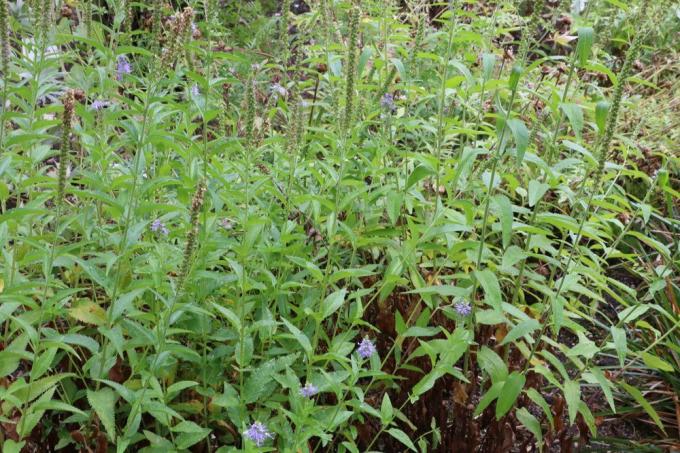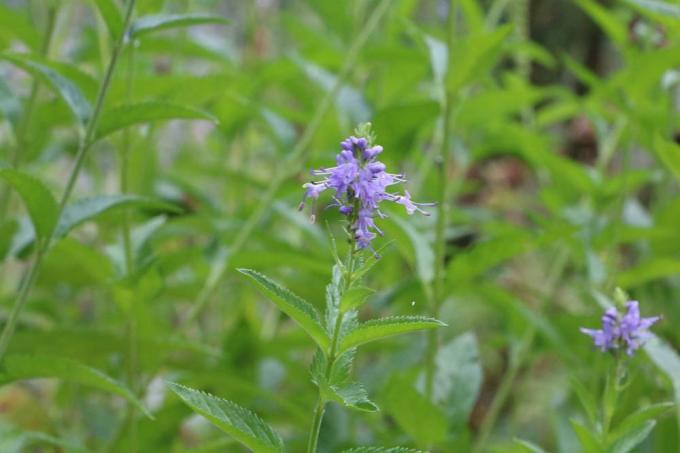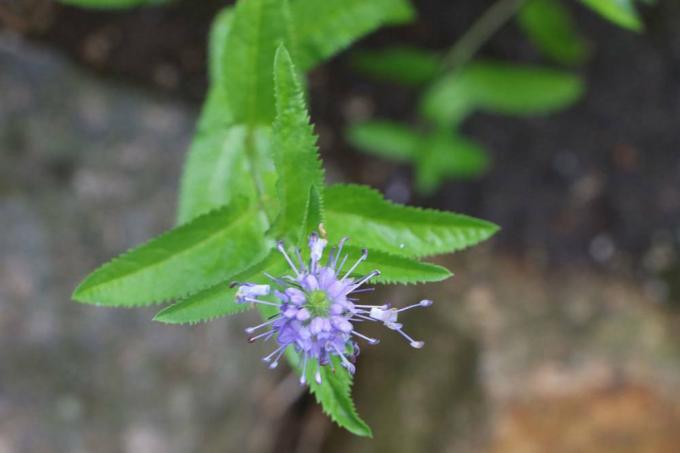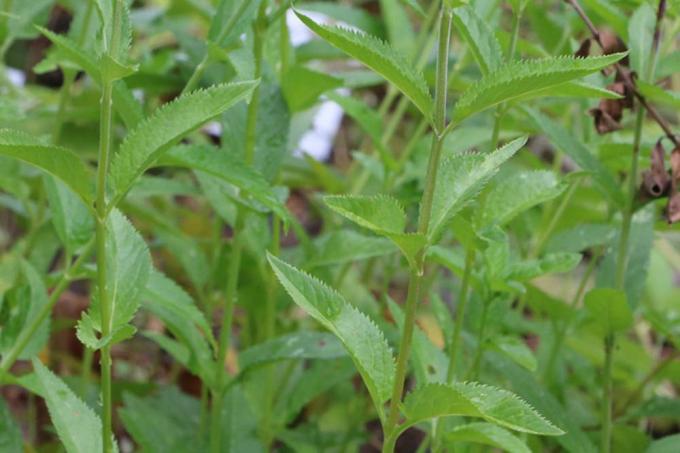
table of contents
- Location
- plants
- care
- to water
- Fertilize
- Cut
- Multiply
- sorts
- Diseases
- species
Profile and care information open +conclude -
- Flower color
- pink, purple, white
- Location
- Partial shade, sunny
- Heyday
- August September October
- Growth habit
- upright, bushy, perennial
- height
- up to 200 centimeters high
- Soil type
- sandy, gritty
- Soil moisture
- moderately moist, fresh
- PH value
- weakly acidic
- Limescale tolerance
- Calcium tolerant
- humus
- rich in humus
- Poisonous
- no
- Plant families
- Plantain family, Plantaginaceae
- Plant species
- Evergreen shrubs, container plants, ornamental shrubs
- Garden style
- Cottage garden, residential garden, ornamental garden
Lush, colorful leaves and a multitude of racemose flowers - these are the distinguishing features of the shrub veronica, which is enjoying growing popularity in our gardens, terraces and balconies. The evergreen plant offers numerous possibilities for garden design because of its biodiversity and inspires with the low demands on care. Unfortunately, the cultivation of this beautiful plant also has a small catch, because it is only partially hardy.
Location
The shrub veronica makes a few basic demands on its location. For example, it might want to be very bright, but it does not tolerate direct sun - especially at lunchtime - so well. Extreme heat, strong temperature fluctuations and frosts are also conditions that lead to the death of the pretty flowering plant in the long run. If you want to cultivate the Veronica for several years in your garden or balcony, you should offer it a protected, cool location.
- Light requirement: bright to partially shaded
- no direct midday sun
- Hebe speciosa also tolerates sunny locations
- protected from wind and heavy rain
- not too warm (maximum 20 degrees)

floor
While the Veronica prefers areas with cool summers and mild winters and therefore makes some demands on its location, it is less picky about the soil conditions. It adapts well to a variety of soil types, but grows best in loose, well-drained soil.
- relaxed
- well permeable to air and water
- moderately nutritious
- pH: 5.8 to 6.5
- not very tolerant of lime
Buy preferred plants
The versatility of the lifts enables the gardener to incorporate the shrub into the garden in a wide variety of ways. Low forms are ideal for planting the borders of beds or rock gardens, while higher forms are ideal solitary plants. When choosing, be sure to buy the right strain for the location you want.
Large-leaved species are almost exclusively suitable for bucket culture, as they cannot tolerate frosts. Even if the label promises otherwise: Lifts are generally only partially hardy (up to a maximum of -5 degrees). The larger species of shrub veronica include, for example, the Hebe andersonii with heights of up to one meter; the Hebe speciosa, which reaches an impressive two meters, is even higher.
plants
The shrub veronica should only be planted outdoors in warm winter regions (wine-growing areas). If you live in a colder area, it is better to plant the shrub in a tub or other planter. If the garden soil is enriched with a little compost, this promotes healthy growth. Very heavy soils also need some sand or gravel to make the soil more permeable for water, because the otherwise robust plant does not tolerate waterlogging.
- Time: in the warmer months between mid-May and early September
- Planting hole: double the ball size
- Planting depth: as before
- Plant spacing: half the stature height
- Water frequently in the first few months
Bucket culture
Since most types of lifting are not sufficiently hardy in our country, they are usually planted in planters or pots. It is important to ensure a well-drained substrate with the correct pH value. The plants thrive well in commercially available compost soil with a proportion of sand. When buying the substrate, make sure that the specified pH value is between 5.8 and 6.5. Very acidic soils or very calcareous soils are less suitable for cultivation. When planting, a thick layer of drainage should be poured into the pot right from the start to avoid waterlogging.
care
Once the Veronica is established in its location, it doesn't require much maintenance. Only a balanced pouring behavior is necessary for healthy growth.

to water
The shrub veronica does not tolerate prolonged drought, but waterlogging is even more of a problem for it. The soil should therefore be kept evenly moist. Before pouring again, the upper layer of substrate is allowed to dry slightly. The root ball of potted plants is watered until the water runs out of the drainage holes. Excess water must be removed from the coaster after about 10 minutes.
Fertilize
In the case of outdoor plants, fertilization is usually not necessary in the first year, provided that the shrub veronica was planted in nutrient-rich, humus-rich garden soil. From the second year it is sufficient to provide them with a little compost or a handful of horn shavings in the spring, which should be easily worked into the soil. In spring, potted plants look forward to a long-term fertilizer for potted or flowering plants. This can be administered as granules or in the form of sticks. Excessive amounts of fertilizer promote the growth of the plant. It then becomes very large, but it hardly forms flowers.
- only fertilize cautiously
- Time: either in late autumn or early spring
- Fertilize outdoor plants with compost
- alternatively Horn shavings or use horn meal
- Preferably supply potted plants with slow release fertilizer
Repot
As with all plants that are grown in pots, the Veronica also needs to be repotted occasionally. This is always the case when the planter is completely rooted, the pot is too small in relation to the plant or the substrate is already very old.
- Frequent checks are necessary at a young age
- For established plants, repotting every two to three years is sufficient
- Time: spring
- never repot during flowering
- shake old earth out of the roots
- Tear or cut open the root network at the edge of the pot with your hands
- Loosen the roots
- the new pot should only be a little bigger
- Remove dead roots
After repotting, the plant should be placed in a little more shade for two to three weeks. A healthy plant recovers quickly from the strain and will soon continue to grow.
Cut
In principle, the Hebe does not have to be cut at all, because it grows very slowly and does very well without pruning. However, the evergreen plant tends to shed from the inside out over time. So that it still grows nice and bushy and compact even after years, it is advisable to prune the plant slightly in spring. Do not prune outdoor plants already in autumn, because this harbors the risk that the Veronica will be even more affected by frostbite during frosts.
- Time: early spring (late March to early April)
- cut all frozen or dead shoots
- prefer to cut regularly, but not much
- Shorten long, unbranched shoots
- aim for a rounded shape overall
- Cut unwooded shoots with a sharp knife
- It is better to cut lignified shoots with secateurs
- Shorten very thick branches with pruning shears or a saw
- alternatively, a blending in autumn after flowering is also possible
- Cleaning out what has faded promotes the formation of new blossoms

Toxicity
The shrub veronica can be cultivated in the garden or indoors in winter without any problems, because neither Shoots and flowers are considered poisonous or contain ingredients that are dangerous for humans and animals can. Since the plant is not poisonous, it is ideal as an ornamental plant for all households in which children and pets live.
Overwinter
Unfortunately, most species of Veronica are only partially hardy. They tolerate light frosts, but if the temperatures drop below -5 degrees for several days in a row, this means the certain death of the pretty flowering plant. In warmer regions such as the wine-growing areas, the shrub veronica can overwinter in the garden, but only under a thick layer of mulch, leaves or straw and a few fir branches or brushwood.
However, good winter protection does not help much in cool regions. Therefore, as a precaution, the plant must be brought into the house. Do not place the Hebe in a warm living room so that you can enjoy the beautiful flowers for a while. A warm winter is not particularly good for the small shrub. In general, the following rule applies: the smaller the Veronica's leaves, the cooler temperatures the plant can tolerate. Since the shrub veronica takes a rest phase in winter and only grows cautiously, it needs a little less water during this time.
- Cover outdoor plants with straw, mulch, leaves
- add a few twigs
- do not cut back too much (then it will freeze to death even faster)
- tolerates frosts up to a maximum of -5 degrees
- Protect from moisture
- Winter in the house: cool and bright
- Temperature: 5-10 degrees
- don't keep too moist
If the wintering place is too dark or too cold, the Hebe sheds its leaves. Then it urgently needs to be moved to a more suitable location. At temperatures between 5 and 10 degrees, the plant can withstand the blazing winter sun completely undamaged. If the shrub veronica is in a garage or a cellar, a special plant lamp can protect against a lack of light.
Multiply
Although the Veronica is a perennial plant, it is still considered to be quite short-lived overall. Count on about five years, under good conditions a maximum of ten. For this reason, it is worthwhile to propagate the plant yourself before its end approaches.
Cuttings
Propagating a shrub veronica from cuttings is not difficult and can also be done by inexperienced hobby gardeners. To do this, use the shoot tips of a branch and cut it off under a leaf base with a sharp, clean knife or secateurs.
- Time: either in winter or in late summer
- Cut healthy, strong shoot tips
- Length depends on the variety
- small-leaved, low-growing varieties: 5 cm
- large-leaved, taller varieties: about 15 cm
- remove lower leaves (about half)
- put in moist substrate
- Planting depth: until shortly before the first pair of leaves
- Substrate: mixture of peat and sand
- alternatively mix cactus soil with a little peat moss
The cuttings of the shrub veronica root easily and can (with summer cuttings) towards the end Repot in regular substrate in September and in a cool, bright place until spring overwinter. Winter cuttings are transplanted in spring. The Veronica looks most beautiful when planted five or six cuttings in a pot. In order to stimulate branching, the young plants should be pricked regularly.

sorts
The Hebe andersonii hybrids are among the best-known species. But there are also a large number of other types and varieties that enrich the balcony, terrace or your own garden many times over.
Hebe andersonii hybrids
'Pink Paradise'
- Height: 40 to 50 cm
- Blossom: light pink to deep pink
- Flowering period: spring, second flowering after pruning
- Leaves: yellowish to white-variegated
'Variegata'
- Height: up to 1 m
- Flower: violet
- Flowering period: summer to autumn
- Leaves: variegated white foliage
Other variants
Raise 'Green Globe'
- Growth height: up to 30 cm
- compact ground cover without flowers
- Leaves: dark green, moss-like leaves
- very easy to cut
- conditionally hardy
Hebe buxifolia (box-leaved shrub veronica)
- Height: 40 to 50 cm
- Flower: white, relatively large
- Flowering period: April to June
- Leaves: only 2 mm in size, lush green, resemble boxwood, very compact growth
- sensitive to frost
Raise 'Heatbreaker'
- Height: 50 to 75 cm
- Flower: white, purple or pink (change color)
- Flowering period: March to August
- Leaves: white-variegated in summer, red in winter and spring
- conditionally hardy (good winter protection necessary)
Raise primeleoides 'Quicksilver'
- Growth height: up to 30 cm
- Flowers: light blue to purple
- Flowering period: from July
- Leaves: very small and silvery green, large spacing between leaves
- looks very slim and filigree
Hebe speciosa
- Height: large variety, up to 2 m
- Flower: purple
- Flowering period: beginning of July to autumn
- Leaves: relatively large, thick and elongated to oval
Hebe ochracea 'James Stirling'
- Height of growth: Dwarf shrub with heights of growth up to 20 cm
- but grows very broadly, good ground cover
- Flower: white
- Flowering period: June to July
- Leaves: pointed, resemble Thuja, moss green to yellowish leaves
- is one of the most frost-resistant types of lifting
Diseases
Diseases and pests
Every now and then the Veronica (especially in warm winter quarters) is attacked by pests such as aphids. Therefore you should check the plant regularly for an infestation.
dryness
Penetrating, long-lasting drought is very damaging to the robust shrub veronica. It is therefore essential to ensure that the heart of the root ball never dries out completely. If some shoots or shoot tips have already died, they can be cut off all year round. Radical pruning is also tolerated without any problems. In this case, however, the Hebe no longer blooms this year.
Waterlogging / root rot
Worse than drought is persistent waterlogging for Veronica. In this case, the roots die and rot, bacteria, viruses and also fungi penetrate the plant through the roots. This can usually be recognized by the fact that the leaves and shoots become limp and yellow before the plant dies. If you act quickly and cut back all the soil and damaged roots down to the healthy tissue, you still have a chance of saving your plant.

species
The shrub veronica, botanically Hebe, does not originally come from here. Most species of the evergreen plant are native to New Zealand, where they prefer to grow in exposed locations in the bushland. The Hebe, which occurs in around 100 different types, is named after the Greek goddess of youth. They are evergreen shrubs that, depending on the species and location, can reach heights of growth of over two meters.
Most of the varieties that you can buy from us in stores do not grow significantly larger than 60 cm. While the spike-shaped inflorescences of all types and varieties are similar, the appearance of the leaves is very different. It ranges from needle-shaped yellow shapes to scaly, gray-blue types to strong green, lanceolate and thick-fleshed leaves. Basically, lifting can be divided into two groups.
1. Small-leaved variants
The small-leaved species of shrub veronica bloom from early May to early autumn. They are somewhat tolerant of frost, but must be protected from severe frosts.
2. Large-leaved species
Species with large leaves bloom in autumn and are evergreen, but they cannot tolerate frosts. That is why they are not suitable for garden planting, but only for container culture.
